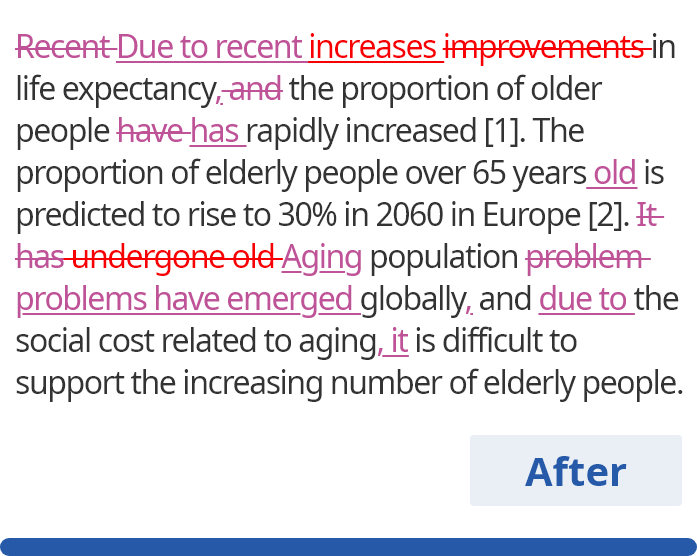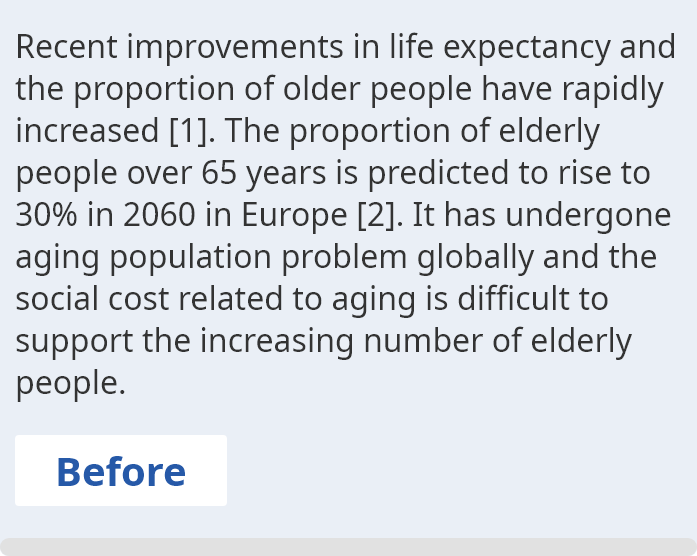クォーテーションマーク(“” ‘’)
クォーテーションマーク(引用符)は実際の会話文の表示や、特定のフレーズを強調するために使う句読点です。クォーテーションマークの使用には見落とされがちなルールが多数あります。大文字使用、引用文内の別の引用、周辺にくる他の句読点との関係などは混同されがちな点でしょう。
クォーテーションマークを使うとき
クォーテーションマークの一番主要な使用目的は、実際の会話文または引用文の表明です。実際の会話文、引用会話文というのは、誰かが言った言葉を一字一句違わず報告することです。ここで言う誰かとは実在する人物もしくは歴史上の人物かもしれません。
- Example
- Einstein once said, “Imagination is more important than knowledge.”
- Example
- Socrates put it best: “The unexamined life is not worth living.”
ただし、実在しないキャラクターの発した言葉や、そのキャラクターが思い浮かべたことを示す際にもクォーテーションマークが使えます。
- Example
- “I don’t feel very much like Pooh today,” said Pooh.
- Example
- “I wonder what Piglet is doing,” thought Pooh.
Run-in 引用とBlock 引用
既存題材の引用には以下の2種類の方法があります。
(1) Run-in 引用:文章内に引用文を挿入する方法
(2) Block 引用:別途引用文を挿入する方法
Run-in引用文は比較的短めで、クォーテーションマークが付いていることで、その周りの文章との区別ができます。
- Example
- Our boss said, “The interns will proof every brief twice.”
- Example
- The paper will be on Kant’s Categorical Imperative: “Act in such a way that you treat humanity, whether in your own person in the person of any other, never merely as a means to an end, but always at the same time as an end.”
一方、Block引用文は比較的長めであるケースが多いです。また、引用文とその周辺の文章がクォーテーションマークで区切られていない代わりに、他の部分とは異なる書式が使われます。Block引用の正確な書式についてはスタイルガイドによって異なりますが、一定の決まりはいくつかあります。
Block引用文のルール
- 1.
- 引用文専用の新たな行から書き出す
- 2.
- 通常のパラグラフとの相違がわかるように字下げする(インデント)
- 3.
- クォーテーションマークは付けない
- Example
-
Kafka’s Metamorphosis is frequently cited as an example of absurdism. It is famous for its opening paragraph:
As Gregor Samsa awoke one morning from uneasy dreams he found himself transformed in his bed into a gigantic insect. He was lying on his hard, as it were armor-plated, black and when he lifted his head a little he could see his domelike brown belly divided into stiff arched segments on top of which the bed quilt could hardly keep in position and was about to slide off completely. His numerous legs, which were pitifully thin compared to the rest of his bulk, waved helplessly before his eyes.
クォーテーションマーク使用のルール
クォーテーションマークの使用にはいくつかのルールがあり、なかには今更言うまでもないルールもあります。例として、クォーテーションマークは常にペアで使う、一対になったペアのクォーテーションマークは互いに向き合っている等々が挙げられるでしょう。
- Incorrect
- Einstein once said, “Imagination is more important than knowledge.
- Incorrect
- Einstein once said, “Imagination is more important than knowledge.“
- Correct
- Einstein once said, “Imagination is more important than knowledge.”
しかし、上記ルール以外にも、他の句読点と一緒の時のクォーテーションマークの使い方、引用セクションの大文字の使い方、引用内に別の引用をどう入れるかなど、クォーテーションの使い方を定めるあまり知られていないルールもあります。
他の句読点と共にクォーテーションマークを使うとき
周辺に他の句読点がある時のクォーテーションマークの付け方には戸惑うことが多いでしょう。例えば、センテンスがピリオドで終わる場合、括りの末尾にくるクォーテーションマークはピリオドの内側または外側のどちらに付けるのでしょうか?
他の句読点と共にクォーテーションマークを使うときのルールは、アメリカ英語かイギリス英語かで異なります。ただし、どちらの英語でも、引用の前にあり、かつ引用そのものの一部ではない句読点は常にクォーテーションマークの前に付けます。
- Incorrect
- According to Socrates “, An unexamined life is not worth living.”
- Correct
- According to Socrates, “An unexamined life is not worth living.”
センテンスを終わらせる句読点についてはタイプ別に異なるルールがあります。
1. ピリオドとカンマは常にクォーテーションマークの内側に付ける。
- Incorrect
- “I don’t feel very much like Pooh today”, said Pooh.
- Correct
- “I don’t feel very much like Pooh today,” said Pooh.
- Incorrect
- Einstein once said, “Imagination is more important than knowledge”.
- Correct
- Einstein once said, “Imagination is more important than knowledge.”
2. コロンとセミコロンは常にクォーテーションマークの外側に付ける。
- Incorrect
- The boss told the interns to “proof the Spector briefs:” a stack of documents tall enough to bury a small child.
- Correct
- The boss told the interns to “proof the Spector briefs”: a stack of documents tall enough to bury a small child.
- Incorrect
- Our boss said, “The interns will proof every brief twice;” she wanted to be sure that the briefs were free of any inconsistencies.
- Correct
- Our boss said, “The interns will proof every brief twice”; she wanted to be sure that the briefs were free of any inconsistencies.
3. 疑問符と感嘆符は、それが引用文の一部である場合にはクォーテーションマークの内側に、引用文の一部でない場合には外側に付ける。
- Incorrect
- She shouted, “I’m so excited”!
- Correct
- She shouted, “I’m so excited!”
- Incorrect
- Why do you roll your eyes every time I say, “Please do the dishes?”
- Correct
- Why do you roll your eyes every time I say, “Please do the dishes”?
引用文と大文字使用の関係
大文字使用に関するルールもよく混同されがちです。
1. 引用文が完全なセンテンスである場合には、冒頭のアルファベットは常に大文字にする。
- Incorrect
- According to Socrates, “an unexamined life is not worth living.”
- Correct
- According to Socrates, “An unexamined life is not worth living.”
2. ただし、引用文が完全なセンテンスではない場合には、冒頭のアルファベットは大文字にしない。
- Incorrect
- The boss told the interns to “Proof the Spector briefs.”
- Correct
- The boss told the interns to “proof the Spector briefs.”
引用文内の別の引用
引用文の中の別の引用文にはシングルクォーテーションマーク(一重引用符)を使います。外側と内側の両方にダブルクォーテーションマーク(二重引用符)を用いると区別がつかなくなるからです。
- Incorrect
- “It is important to self-reflect,” said Lana. “In the words of Socrates, “An unexamined life is not worth living.””
- Correct
- “It is important to self-reflect,” said Lana. “In the words of Socrates, ‘An unexamined life is not worth living.’”
タイトルと注意喚起に使うクォーテーションマーク
クォーテーションマークは強調を示す目的でも使われます。記事や本の章など、比較的短めの作品のタイトルを目立たせる目的でクォーテーションマークを使います。
- Example
- The first chapter of Harry Potter is “The Boy Who Lived.”
言葉の意味というよりも、機械的に「言葉」そのものとして使われていることを示す際にもクォーテーションマークが使えます。
- Example
- According to Merriam-Webster, a “book” is a set of written sheets of skin or paper or tablets of wood or ivory.
クォーテーションマークが他によく使われるのは、注意や疑惑を表す時です。このような使われ方をするクォーテーションマークは「注意喚起の引用符」と呼ばれ、読み手に言葉、用語やそれを取り巻くフレーズの正当性について疑問を抱かせる役目があります。以下の2つのセンテンスを比較してみましょう。
- 注意喚起の引用符なし
- The class is optional.
- 注意喚起の引用符あり
- The class is “optional.”
最初のセンテンスは、その授業を履修しない選択をしても何ら問題はないことを示唆しています。それに対して2つ目のセンテンスでは、厳密には、その授業を履修しない選択は可能だが、現実は、履修しないとマイナスの結果につながる可能性もあることが示唆されています。別の言い方をすると、その授業の履修は書面上は任意とされているが、実際のところはほぼ必須だという意味が含まれています。
シングルクォーテーションマーク(一重引用符)
シングルクォーテーションマークは、引用内の別の引用の時以外にもいくつか他の用途があります。アカデミックライティングでは、ある特定分野における特殊な専門用語が頻繁にシングルクォーテーションマークで括られています。このような慣行は規則というわけではないものの、例えば哲学や神学といった、日常語が専門用語として使われる一定の分野では標準的用法とみなされています。
- Example
- Much of moral philosophy has been concerned with defining the meaning of ‘goodness’.
ニュース記事の見出し内の引用箇所を表すのにもシングルクォーテーションマークが頻繁に使われています
- Example
- Drug companies ‘put profits over lives’.
最後に、シングルクォーテーションマークは、文中翻訳を括る丸括弧の代わりにもなります。
- Example
- He said Entschuldigung, or ‘excuse me’, when he bumped into her.
アメリカ英語とイギリス英語で使うクォーテーションマークの違い
当ガイド記事で列挙したルールはアメリカ英語固有のものです。ほとんどのルールはイギリス英語にも同様に適用されますが、以下の3つの主要な相違点があります。
1. イギリス英語では、会話文や引用文に対してもシングルクォーテーションマーク使用が好まれます。
- Example
- Einstein once said, ‘Imagination is more important than knowledge’.
2. 引用文内の別の引用では、イギリス英語は外側にくる引用符にシングルクォーテーションマークを、内側にくる引用符にダブルクォーテーションマークを使う。これはアメリカ英語の場合とは逆です。
- Example
- ‘It is important to self-reflect’, said Lana. ‘In the words of Socrates, “An unexamined life is not worth living.”’
3. イギリス英語では、それが引用文の一部である場合を除いて、句読点は常にクォーテーションマークの外側に付けます。
- Example
- The boss told the interns to ‘proof the Spector briefs’.
引用符の使い方をマスターすれば、読み手に誤解を与えることなく、明確で正確な英文を書くことができるようになります。専門家による校正を受ける前に、句読点チェッカーなどのツールを活用して、細かいミスを防ぐこともおすすめです。













